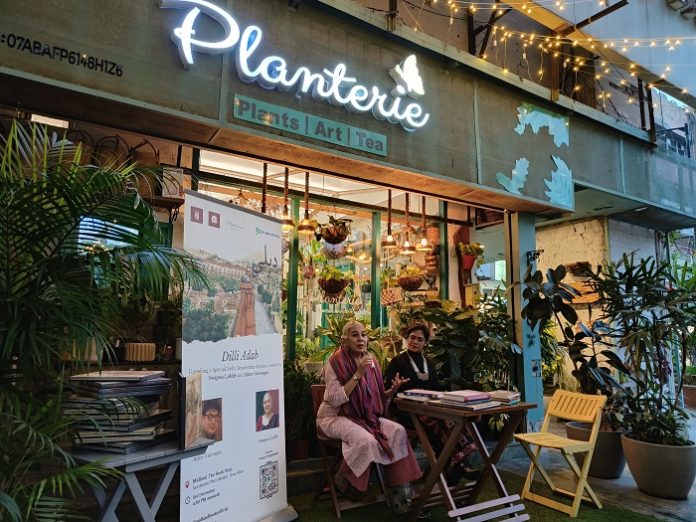Midland Books – a well-known bookstore in Delhi – in collaboration with Anjuman Taraqqi Urdu (Hind) unveiled Dilli Adab, a special readership section on Delhi curated by historian Swapna Liddle and Urdu and English translator Ather Farouqi at its Hauz Khas premises on 3 December 2023. The permanent dedicated section is aimed at showcasing the finest books on Delhi to its readers and is said to be the first such initiative in the capital.
“Midland has done a great job of curating the finest book on Delhi in English, Hindi, and Urdu in one place. Usually, when you visit bookstores in the city, Hindi and Urdu books are hard to come by. If people come across books in these languages in bookstores, their readership is sure to go up. Readers will get better acquainted with the history of Delhi,” Swapna Liddle said.
Ather Farouqi, who was unable to make it to the event, shared a message through the organizers. “All of you should try to learn Urdu as reading about Delhi in Urdu has its unique appeal and flavor, which is difficult to match while reading translations.”
Mirza Zuber Baig from Midland Books said the purpose of the special Delhi readership section is to let readers know that there is so much about the history of Delhi that has been written in Urdu, Hindi, and English. “This is one of our initiatives to help readers to know more about the city of Delhi. No one has done this in Delhi before, and even though many enthusiasts have been collecting books at many places in the city, a special section dedicated to Delhi and its history has begun at Midland Books at Hauz Khas. Readers can also find the curation online on our special bookshelf on our website (www.midlandbookshop.com/en/).”
The inauguration by Swapna Liddle was followed by a panel discussion at Planterie in Aurobindo Place Market in Hauz Khas, a one-stop studio to create a greener and healthier urban living space. Students, bookshop regulars, and history buffs attended the event.
Ritu Mehra, who has worked as a translator and was a part of the team at the Partition Museum in New Delhi, joined Liddle in exploring the mass appeal of the body of literary work on the city of Delhi. Liddle has authored many books on Delhi, including The Broken Script Delhi Under the East India Company and the Fall of the Mughal Dynasty, 1803-1857; Shahjahanabad: Mapping a Mughal City; Delhi: 14 Historic Walks; Connaught Place and the Making of New Delhi; and Chandni Chowk: The Mughal City Of Old Delhi.
Liddle said, “I have had a very long relationship with Midland going back to my initial research days. Midland was one of the few mainstream bookshops that had an Urdu section, which contributed a lot to the research on my books. Midland has been keeping Urdu books for long, and giving them prominence. When I visit the store, I get to know which books on Delhi have come up with new editions and which ones are still in print, and available to readers.”
Abroad, the first thing one would notice at any bookshop is the section of books on their cities Liddle said, adding this is missing in many bookshops in India. “People are interested in reading about the city – its history, culture and traditions. This is how this idea came about and Anjuman Taraqqi Urdu (Hind) took the initiative in curating this section on English and Hindi translations of Urdu texts along with the Urdu originals,” she added.
Book recommendations on Delhi
Sair Ul-Manazil: Delhi ka Samaji Jugrafia written by Asghar Ali Baig entitled Mirza Sangeen Baig and translated by Professor Sharif Husain Qasemi is a seminal text on monuments and one of the classics of Persian literature. Liddle said the text includes many original inscriptions on the monuments of Delhi. “I think more people should learn the Urdu script, as once you master the language, it opens up a world of opportunities,” she added.
Bazm-i Aakhir by Munshi Faizuddin, translated by Ather Farouqui as The Last Gathering: A Vivid Portrait of the Life in the Red Fort, is another important book that talks about the Mughal court in the era before 1857. It is a very interesting description of the systems, traditions, festivals and basically what was happening in the Red Fort during that time. The Mughals had developed a very syncretic culture and that comes out beautifully in this book, Liddle said.

Written in 1885, just a few decades after the fall of the Mughal empire, it says nothing of the British presence in Delhi and is all about nostalgia and trying to recreate what is supposed to be a pristine culture. It does not tell us about how a lot of cultural change was coming and gives a very skewed or incomplete picture of the Mughal dynasty, she added.
Author Swapna Dutta has written a very appealing book The Story of Red Fort for children. Liddle said INTACH (Indian National Trust for Art and Cultural Heritage) has also brought out certain books on Rashtrapati Bhavan and the capital Delhi for children along with one on Let’s Explore Humayun’s Tomb by Narayani Gupta with beautiful illustrations by Anitha Balachandran, brought out by Archaeological Survey of India (ASI). “I think there is a lot of scope in bringing out books on Delhi targeted at children as it helps develop an interest in the history and culture of the city and publishers should make a note of it,” she added.
Liddle said her most important book based on the amount of original research is The Broken Script Delhi Under the East India Company and the Fall of the Mughal Dynasty, 1803-1857. “This book captures a lot – from the Mughal Empire to the working of the East India Company as the administrators of Delhi. It talks about the culture of Delhi in the last few years of the Mughal dynasty in Delhi. I have tried to dispel certain misconceptions through the book,” she said.
Many know that the Archaeological Survey of India was established by Alexander Cunningham in the 1860s. However, the Archaeological Society of Delhi was the predecessor to the ASI, formed by the colonials with the help of Indians such as Sir Syed Ahmed Khan, who contributed research on the Qutub Minar, the Jantar Mantar, and the analysis of bricks. The mapping of the historical cities of Delhi and analysis of coins were all done as proceedings of the Archaeological Society of Delhi, Liddle said. “What is missing in the history of these institutions is the role that Indians played in them and is obscured from many historical accounts,” she concluded.

















